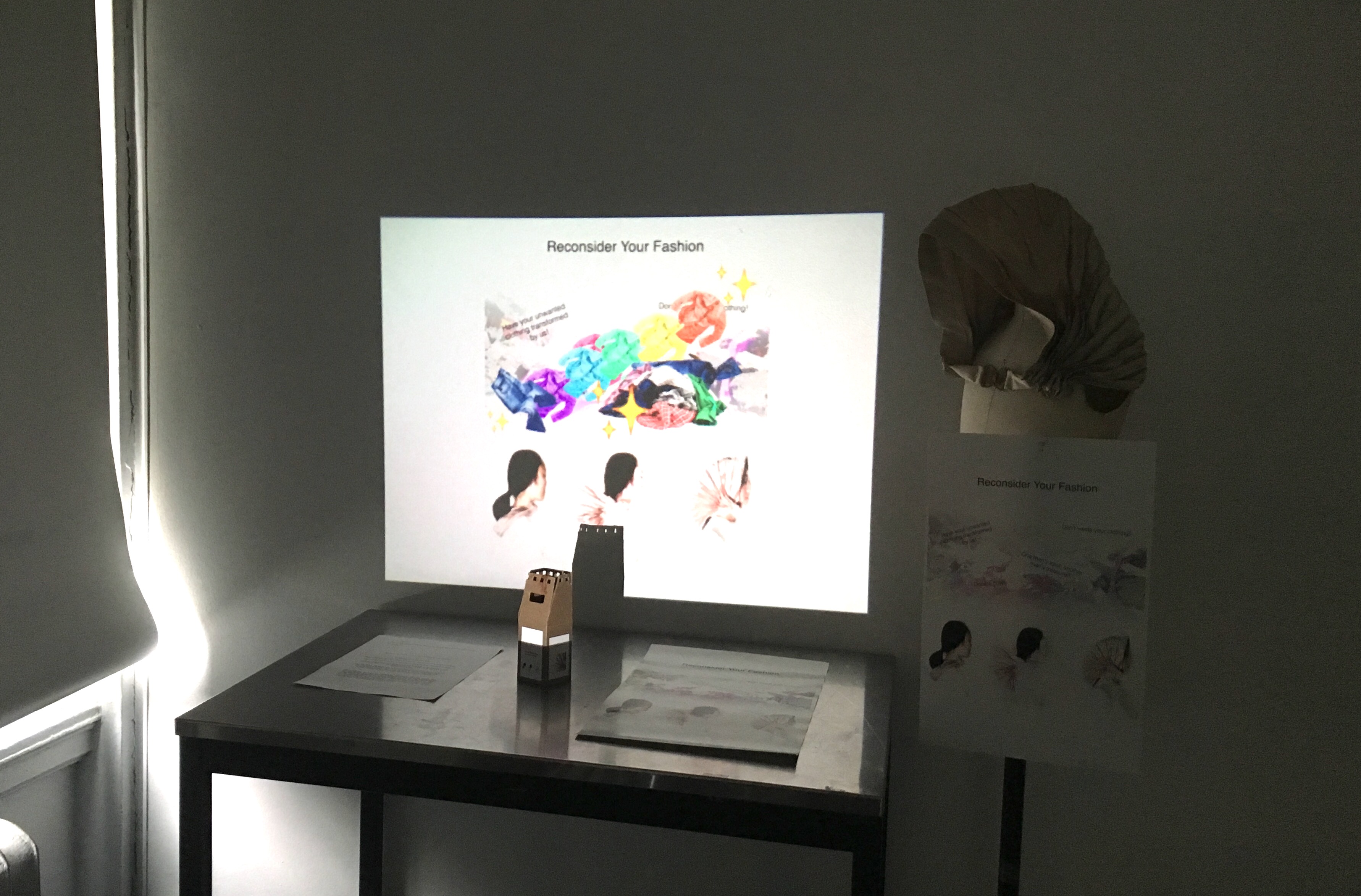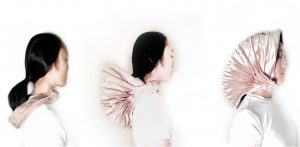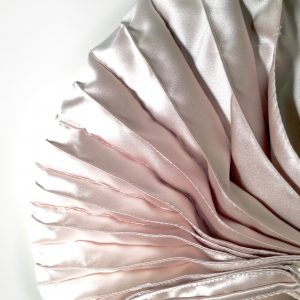The aim of this final project is to design a resiliency-building intervention (action, a service, a thing, a campaign etc) that relates to one of the course topics: Climate Change: Air, Energy, Materials, and Water. This is done by researching the one topic and engaging with communities/activist organisations such as citizen scientists, lobby & advocacy groups, government agencies, community organisations or others that are addressing, or affected by the specific topic.
Introduction to Issue
Chosen Topic: Materials
I wanted to work with materials and fashion because as a student studying fashion design, it is important to advocate and understand the impact the textiles industry have on global warming. The textile industry, according to the U.S. Energy Information Administration, is the 5th largest contributor to CO2 emissions in the United States, after primary metals, nonmetallic mineral products, petroleum, and chemicals.[1]
The process of new clothing production is really harmful to the environment including dyeing of fabrics, creating synthetic fibers, growing cotton crops etc.
Problems: [2]
-“About 5% of every landfill is textiles.”
-“Salvation Army in Brooklyn builds a wall of 18 tons of unwanted clothing every 3 days.”
-“A single mill in China uses 200 tons of water for each ton of fabric it dyes. Many rivers in China run with the colors of the season, as the untreated toxic dyes wash off from mills.”
-“Nitrous oxide is released when manufacturing nylon. Nitrous oxide is a greenhouse gas that is 310 times stronger than carbon dioxide.”
-“22% of all insecticides used worldwide are sprayed on cotton crops.”
RESEARCH
Existing activist communities/groups:
- re-fashioNYC
What they do: Make clothing donation as easy as possible, through a convenient in-building service, 100% nonprofit, partnered with housing works, places convenient and attractive donation bins in residential buildings, resells in thriftshops. [3]
- Wearable Collections
What they do: Place recycling bins in residential buildings for free, clothes are filtered to either be reused or turned into fibers. Raises money for charity, keep clothing out of the landfill. [4]
- The GreenShows
What they do: Event, education and consulting company dedicated to promoting and growing the luxury sustainable fashion movement, produces seasonal fashion shows, only showcases fashion that is sustainable. Have a list of sustainable materials for designers, strict design criteria. [5]
I made a trip down to check out one of the bins at the residential areas. This is how the bins look like:
Image Source: https://twitter.com/hashtag/refashionyc
I observed that the design of the bins was pretty sturdy and portable. It was also heavy, people were actually donating a lot of clothes to them. I wanted to find out more so I interviewed someone from re-fashioNYC.
Interview (Volunteer at re-fashioNYC)
Volunteer preferred to stay anonymous, hence he will be referred to as “V”. The length of the full interview was also cropped for relevance purposes.
Me: How often do you volunteer for re-fashioNYC, what do you do?
V: I’m actually only volunteering for this month, I assist in picking up the clothing from the bins and organizing some of the clothes at their thriftstores.
Me: What exactly does “Sustainable Fashion” mean? (There are so many people who claim they are doing sustainable fashion, but are they really?)
V: Well there are several ways to define sustainable fashion I guess. Personally, I feel that it depends on your own perspective, I would consider buying from a thriftstore sustainable, it does not require any new materials, however, I don’t think that using less harmful materials is being sustainable. Just because you use something that is less harmful to the environment, it does not mean that you didn’t cause harm, you still did, but less harm, but there is still harm. And yeah, even now there are a lot of fast fashion labels claiming to be sustainable, which I shall not mention you probably know which I’m talking about. Fashion cannot be “inspired” by sustainability, it cannot be superficial, it cannot just “look” sustainable, it actually has to be, in measurable ways, with regards to global warming. The last thing you want to do is exploit the name of sustainability to go against it, I think that is terrible.
Me: Oh you are an artist yourself! How do you incorporate sustainability into your works?
V: Yeah it is not easy especially when it is so convenient to just grab toxic glue from the art store. I have been making my own glue with corn flour and starch. There are actually a lot of biodegradable materials out there that you can source for. My friend was making this work with dried orange peels. Now you can even grow mycelium from mushrooms to mold things, the possibilities are really pretty endless.
Me: To what extent does being sustainable really help towards climate change?
V: I think it is definitely a big extent, I can go on forever. *laughs* One very simple example is that we all know 6% of New York City waste materials are textiles. That is so much, if everyone or even most people, could just donate their stuff, imagine the impact that would have on the demand for fast fashion. People would also then buy more second-hand items if only they are actually aware of the big difference they can make.
Me: What do you think of the responses people are having towards these clothing recycling bins?
V: People are actually responding very well, every time we come to collect the stuff the bins are always full, I guess it is really convenient as well, it does not take much effort to put your clothing in our bins than to trash it. I think it is also important to provide people with easy access to recycling, everyone is always busy in the city, if it takes an extra effort, not a lot of people are going to do it.
Me: What do you think stops people from buying recycled or second-hand clothing?
V: Some of my friends tell me that they don’t really want to shop at thrift stores because they think that it is unhygienic, you don’t really know who wore it, how long it has been there, where it has been… However, we do clean the items before putting them out in the stores. People also sometimes for some reason tend to think that thrift store’s clothing are old, outdated and out of style, which I really don’t believe so. I have found some gems in thrift stores and once in a while, I do enjoy pulling off that grandfather look. *laughs*
IDEATION
Creating a Campaign.
After my research, I have decided to create a small-scale campaign within Parsons because I wanted it to be practical and actually feasible. There are lots of activists communities and big sustainable fashion companies out there, however, I feel that change can start within the school and in influencing the friends around me. Small change is still measurable change. I also already have the resources I need here, to start this campaign.
The problem to effectively solve is to direct consumers towards buying recycled clothing, instead of new clothing like fast fashion. What if consumerism towards new clothing lowers? The pollution in manufacturing them also lowers, the landfill would also lower as a result. This makes it sustainable. However, consumers can sometimes tend to think that recycled clothing can be outdated in terms of style and can be unhygienic.
This campaign will be called, “Reconsidering Your Fashion”.
It will feature a series of events.
Step 1) Gather a bunch of about 10 students who are studying Fashion Design.
Step 2) Collect as many unwanted clothing from the school dorms as possible.
Step 3) Using collected clothing, the 10 students will deconstruct them, and reconstruct them into a new fashion statement. They will design and make a series of garments.
Step 4) A booth will be set up in school and the new garments made will be for sale. The sales collected will go to re-fashioNYC. Flyers and posters will be given out at the booth to encourage students to continue donating their clothes, whether to us or to public organizations like re-fashioNYC.
The graphic below illustrates the system my topic exists within:
This is my point of intervention:
By providing an alternative option for consumerism, it lowers the consumerism towards fast fashion and rapidly newly manufactured clothing. This way, consumerism can remain standard, directing its flow towards recycling, instead of increasing manufacturing with that feedback loop, that otherwise flows towards climate change. A new healthy feedback loop is created between consumerism and the blue box. This makes for a sustainable system between them as they feed off each other and sustain each other. This fosters resiliency.
ITERATION
This campaign advocate for sustainable fashion by showing people that recycled fashion does not have to look outdated. We are also helping each other source for materials for fashion projects instead of buying them. This instills recycling culture in school. It also raises the awareness of the impact the textiles industry have on climate change. It supports other existing communities in the collection of clothing donation and educates the urgency to start fashion from a sustainable perspective.
One of my friends gave me a dress that she no longer wanted. I deconstructed it and made the following as a fashion item:
This example of reusing recycled fashion will be used to make my poster for the events as well as the bin prototype to collect the clothing from.
Poster:
The prototype for Bins to be placed around school dorms for clothing collection:
Final Exhibition
Footnotes
[1] Energy Information Administration, Form EIA:848, “2002 Manufacturing Energy Consumption Survey,” Form EIA-810, “Monthly Refinery Report” (for 2002) and Documentation for Emissions of Greenhouse Gases in the United States 2003 (May 2005). http://www.eia.doe.gov/emeu/aer/txt/ptb1204.html
[2] http://www.lexidaly.com/fashion-industry/
[3] http://www1.nyc.gov/assets/dsny/zerowaste/residents/re-fashionyc.shtml
[4] http://wearablecollections.com/
[5] http://www.thegreenshows.com/index.html










